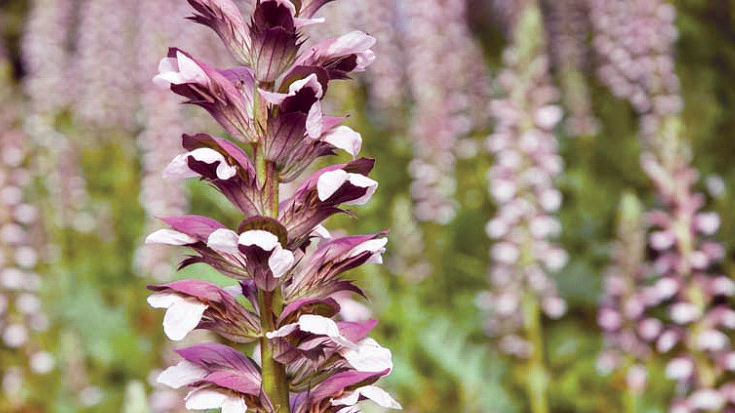
By Leora McTall, Washington County Master Gardener
First, what are Bear’s Breeches? Are they trousers for bears? Bear’s Breeches is the common name of a plant, Acanthus. Some may ask why this large, beautiful perennial plant would have such a name. Probably the most honest answer to this question is “the origin of the name, Bear’s Breeches is disputed.”
Bear’s Breeches flowers were first seen by this gardener at the Missouri Botanical Garden in a huge bouquet of two foot tall spikes of dusky violet and white blooms. At first one would guess these flowers were silk or some other fake material, but upon closer examination, they were real and alive!
Next, a Bear’s Breeches plant was found, purchased, and planted here in Irvington, right at our front porch. But over time it proved to be rather pitiful with hardly any blooms and the whole plant just sat there pouting.
So, what to do? Gardeners are always digging up plants to relocate them to a better site, one that would encourage growth and bloom. So, the Bear’s Breeches were moved from the east side of the house around to the west side — from full morning sun to dappled shade — and before we knew it beautiful tall spikes of flowers bloomed, and the plant flourished. Now we can depend on it returning every year for a show of shows!
The foliage of this beauty is almost as popular as the flower. The shiny, deeply lobed leaves form a large rosette as a base where the flower spikes emerge. These leaves inspired the architectural design on top of Corinthian columns, still seen in ancient ruins and are used today in current architecture. On another level, Acanthus leaves are used as decorations on tombstones to symbolize immortality.
Our friend, Lucy, saw Acanthus mollis growing wild in Rome, it’s native habitat. There are over 30 varieties of Acanthus — A. helanicus; A. mollis; A. spinosus — to name a few of the more well-known. Although the basic colors are shades of purple and white, there are a few varieties of pink and even a white flowering variety called “Whitewater.” These stately beauties bloom for three to four weeks, preferring the shade and do produce nectar to attract pollinators.
So, if a modest bear is seen in your garden, you may want to plant some “Bears Breeches.”
For horticulture questions, contact your University of Illinois Extension Office, or a Master Gardener.





